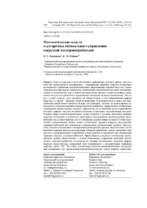| dc.contributor.author | Рахмонов, И. У. | ru |
| dc.contributor.author | Реймов, К. М. | ru |
| dc.coverage.spatial | Минск | ru |
| dc.date.accessioned | 2019-11-29T08:02:40Z | |
| dc.date.available | 2019-11-29T08:02:40Z | |
| dc.date.issued | 2019 | |
| dc.identifier.citation | Рахмонов, И. У. Математические модели и алгоритмы оптимального управления нагрузкой электропотребителей = Mathematical Models and Algorithms of Optimal Load Management of Electricity Consumers / И. У. Рахмонов, К. М. Реймов // Энергетика. Известия высших учебных заведений и энергетических объединений СНГ. – 2019. – № 6. – С. 528-535. | ru |
| dc.identifier.uri | https://rep.bntu.by/handle/data/60956 | |
| dc.description.abstract | Один из основных путей обеспечения экономичных режимов работы энергосистем при краткосрочном планировании – выравнивание графиков нагрузок посредством оптимального управления электропотреблением. Выравнивание графиков нагрузок с целью снижения расходов можно осуществить привлечением потребителей на основе административных и экономических мер. Административные меры связаны с принудительным ограничением нагрузок потребителей в определенных интервалах периода планирования. Эти меры, с одной стороны, дают выигрыш для энергосистемы за счет выравнивания графика нагрузки, а с другой – приносят ущерб потребителям. В конечном итоге в целом для энергосистемы ущерб может оказаться больше, чем выигрыш. Поэтому их целесообразно использовать в условиях дефицита электроэнергии и мощности в энергосистеме. Оптимальное планирование краткосрочных режимов энергосистем по полученным после выравнивания жестким графикам нагрузок потребителей можно осуществить традиционными методами. Решение данной задачи первоначально следует провести в условиях нежестких графиков нагрузок, получаемых в результате директивного использования административно-экономических мер, осуществляемых за счет специально разработанных моделей. В статье предложены математическая модель задачи оптимизации графиков нагрузок регулируемых электропотребителей при оптимальном планировании краткосрочных режимов энергосистем, алгоритм оптимального планирования краткосрочного режима энергосистемы с оптимизацией графиков нагрузок регулируемых электропотребителей, а также алгоритмы учета простых и функциональных ограничений в виде равенств и неравенств при оптимизации графиков нагрузок электропотребителей. Эффективность алгоритма оптимизации кратко-срочного режима энергосистемы с учетом оптимального управления нагрузкой регулируемых электропотребителей исследована на примере оптимального покрытия графика нагрузки энергосистемы, содержащей двух потребителей с регулируемыми графиками нагрузок, двумя ТЭС. На основе проведенных расчетно-экспериментальных исследований установлено, что предложенная математическая модель задачи является адекватной, разработанные алгоритмы оптимального планирования краткосрочных режимов энергосистем с оптимизацией графиков нагрузок регулируемых электропотребителей и учетом различных видов ограничений обладают высокими вычислительными качествами. | ru |
| dc.language.iso | ru | ru |
| dc.publisher | БНТУ | ru |
| dc.title | Математические модели и алгоритмы оптимального управления нагрузкой электропотребителей | ru |
| dc.title.alternative | Mathematical Models and Algorithms of Optimal Load Management of Electricity Consumers | ru |
| dc.type | Article | ru |
| dc.identifier.doi | 10.21122/1029-7448-2019-62-6-528-535 | |
| local.description.annotation | Load profile alignment based on optimal power consumption management is considered to be one of the main ways to ensure efficient operation of energy systems in the short-term plan-ning. Alignment load profile with a view to reducing costs can be implemented with the aid of consumers’ involvement by administrative and economic measures. Administrative measures are associated with the forced restriction of consumer loads in certain intervals of the planning period. On one hand, these measures provide benefits to the power system by alignment load profile, and on the other hand, they cause detriment to consumers. Ultimately, in some cases, for the whole power system, the detriment may be greater than the benefits. Therefore, it is advisable to use administrative measures in conditions of shortage of power and electricity in the power system. Optimal planning of short-term regimes of power systems according to rigid load profile received after alignment can be carried out by traditional methods. The solution of such a problem ought to be initially carried out under conditions of non-rigid load profile resulting from the directive use of administrative and economic measures carried out with the help of specially developed models. In this regard, the paper proposes a mathematical model of the problem of opti-mizing load profile of regulated electricity consumers to be used for optimal planning of short-term power system modes, an algorithm for optimal planning of a short-term power system mode with optimizing load profile of regulated power consumers. Also, algorithms are proposed for accounting for simple and functional constraints in the form of equalities and inequalities when optimizing load profile. The effectiveness of the described algorithm for optimizing the short-term mode of the power system, taking into account the optimal load control of adjustable electricity consumers, has been studied using the example of optimal coverage of the load profile of power system, which contains two consumers with adjustable load profile, and two TPPs. Based on the calculated-and-experimental studies, it was determined that the proposed mathematical model of the problem is adequate, while the developed algorithms for optimal planning of short-term power system modes with optimization of load profile of regulated electricity consumers and taking into account various types of limitations are of high computational qualities. | ru |

